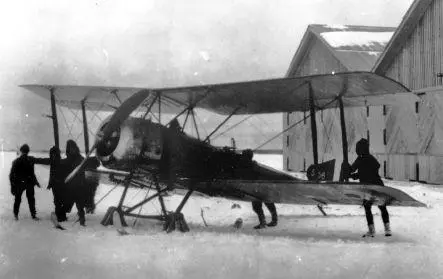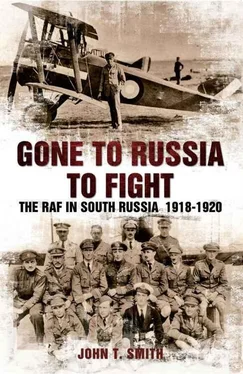Collishaw claimed that he was carrying out combat sorties from 17 January, but the squadron records show that no flying by A Flight took place during January.
47 Squadron (A Detachment) was now split into two distinct parts. General Maund decided that A Flight, with Collishaw in command, was to be known as the Crimea Group. The other three flights, C Flight, B Flight, and Z Flight, were to be known as the Kuban Group, under the command of Captain Slatter. Z Flight was now under the command of Lieutenant Ritchie. Lieutenant Vic Clow from Z Flight contracted malaria during January and was invalided home to Britain.
Rightly or wrongly, it seems that General Maund was blamed for the substantial loss of aircraft, equipment, and stores at Taganrog. In the middle of January, he was asked to resign by General Holman. General Maund stated that the reason he resigned was to highlight the incompetence of the Russian general in charge of the White air force, General Kravtseyvitch. But this may have been an excuse. In any case, General Tkatcheff, who had commanded a large part of the Imperial air force, replaced General Kravtseyvitch. But, for whatever the reason, on 30 January 1920, General Maund left Russia for Constantinople. He was reduced from acting brigadier general to his substantive rank of major and was replaced by Major Archer as RAF commander in south Russia.
The RAF claims to have ‘rendered useless’ the equipment lost at Taganrog, but the Soviets state that they did use some of the captured equipment. A list of the material lost at Taganrog included eight RE8s, including five still in crates, six SE5As (these had been delivered months before but never used because the correct propellers could not be obtained), and five Camels, plus a large amount of motor transport and spares. B Flight’s train had included five Camels and eight Clerget engines, in addition to the motor transport. The second A Flight train had included five DH9As, spares, and motor transport.
Tanks being evacuated from Novorossisk to the Crimea in early 1920.
As part of the restructuring, the air park at Novorossisk was to be increased in size to get as many aircraft ready as possible. Acting Major Clemson, who had been part of the Training Mission, was placed in command. Captain Head, also from the Training Mission, was in charge of the airfield at Novorossisk. By 23 January, at least one RE8 had been assembled. Also, eight DH9s and six Avro 504s were stored in crates on the docks at Novorossisk. A decision had been taken to send Avro 504 aircraft to help the Russian training organisation. Captain Kinkead and the rest of the B Flight men were in Novorossisk, trying to re-equip and re-establish the flight after losing all their kit on the train at Rostov. On 15 January, Captain Head requested permission to be married, followed by Captain H. S. (Sporty) Murton on 20 January.
It was decided to move the tank school to the Crimea, where it was thought to be possible to hold out against the Bolshevik advances. Most of the tanks were shipped to the Crimea during February, from the port of Novorossisk.
General Holman, in his report on the retreat, expressed admiration for ‘the fighting unit of the RAF who have been to the front’:
Their behaviour has been admirable in all respects and I put the fact on record with great pleasure and keen appreciation of their good services. [7]
December and January had been a very trying time for the RAF in south Russia.
CHAPTER EIGHTEEN
FEBRUARY 1920
The Red Army continued to press the remnants of General Denikin’s Army back into the Caucasus during February. General Budenny, with the cavalry corps, was moved to attack the White Army on its right flank. But the White troops were not finished yet. During an attempt to cross the Manych River, Budenny’s troops were heavily defeated. This was the same River Manych that General Wrangel had crossed in May 1919 to destroy the 10th Red Army. The Kuban Cossack leadership began to have serious disagreements with General Denikin and large numbers of Kuban troops surrendered to the Red forces. The Don Cossacks, on the other hand, remained loyal to Denikin to the end.
In a last throw, what was left of the Volunteer Army and the Don Cossack troops crossed the frozen River Don and recaptured Rostov on 20 February. But the success was shortlived, as Denikin had no reserves to back up the troops in Rostov. The Red Army recaptured the town on 23 February. Late in the month, General Budenny crossed the Manych River and began to advance down the rail line to Ekaterinodar. After disagreements with General Wrangel, General Denikin sacked him on 23 February and he left for the Crimea, where he owned a house. Wrangel, in his memoirs, claimed he resigned.

A Sopwith 1½ Strutter with skis.
The White troops who had retreated into the Crimea continued to hold the Red Army at the easily defended Perekop Isthmus. A Flight was still at Simferopol, trying to get the aircraft they had been given by the Russians into airworthy condition. On 1 February, Captain Breakey and Lieutenant Chubb took off in a DH9 on a reconnaissance flight but soon had to return with the ‘rudder badly knocked out of place’. On 3 February, Major Archer, who was now in command of the RAF in south Russia, and Captain Slatter flew a DH9A from Ekaterinodar to the Crimea for talks with Collishaw. They returned the same day. Captain Breakey finally managed to carry out a successful flight on 4 February, with Lieutenant Chubb as his observer, attacking troops in the Perekop sector of the front with machine-guns.
Bad weather on 5 February forced Breakey to call off a reconnaissance flight and return to base because of fog and low cloud. On the night of 5 February, the RAF contingent received news that a Bolshevik uprising was about to take place. The RAF men were armed and spent the night patrolling around their train, but nothing happened. The same thing occurred on the night of 9 February, but again nothing happened. Bad weather stopped any more flying until 13 February. The A Flight train moved forward to the airfield at Djankoi on 12 February; one DH9 was flown to the new field on 13 February and the other one on 15 February. The Russians had provided another DH9, and Lieutenant Langley proceeded to the aircraft park at Simferopol to fly it back to Djankoi. Captains Grigson and Gordon carried out a successful flight on 16 February; although the cloud base was only 300 feet, two 65 lb bombs were dropped on rolling stock to good effect and horse transport on a road was fired on, causing panic.
The Red air force mounted two bombing raids on Djankoi on 17 February. Only four small bombs were dropped: two failed to explode and two missed the intended targets. A Flight sustained no damage. Captains Grigson and Gordon were in the air again on 18 February. The railway station at Novo-Aleksyeevka was bombed with sixteen 20 lb bombs. The station was full of rolling stock; direct hits were obtained and several buildings were set on fire. Inaccurate AA fire was seen from an armoured train in the station. Grigson’s combat report reads:
Combats in the Air. A Flight, 18/2/20, 1520hrs. DH9 2874. Novo-Aleksyeevka, Armament 1 Vickers and 1 Lewis, Height 2,000-3,000ft. Pilot Capt J. W. B. Grigson, Observer Captain C. F. Gordon, Result – Driven down 2 miles S. W. of Novo-Aleksyeevka. Type 1 and a 1/2 Sopwith Strutter fitted with skis for landing on snow. While engaged in bombing the station of Novo-Aleksyeevka an enemy machine was seen circling to gain height to attack. The bombing was finished at a height of 3000ft. and the enemy machine was still below at about 2,500ft. was then attacked after several bursts had been fired from our rear gun the Sopwith endeavoured to make off with his nose well down. We chased him and got into position for several more bursts from our Lewis gun from about 2,000ft. He was then at about 1,700ft. and immediately dived and landed about 2 miles SW of Novo-Aleksyeevka station in open country. Two men were seen to get out and run towards the station, no tracer ammunition was fired by the enemy. [1]
Читать дальше













